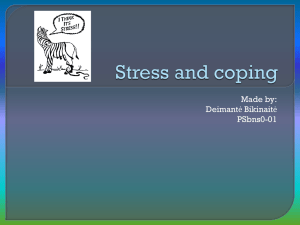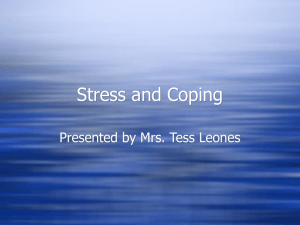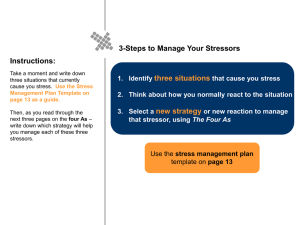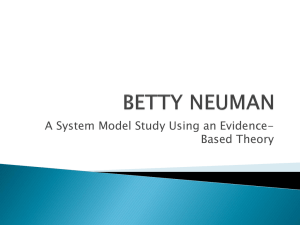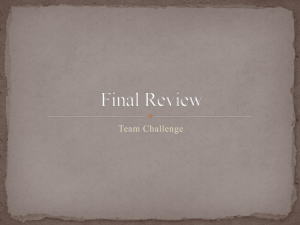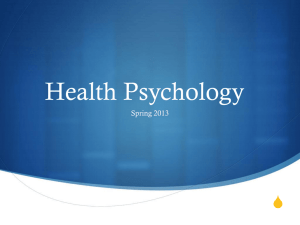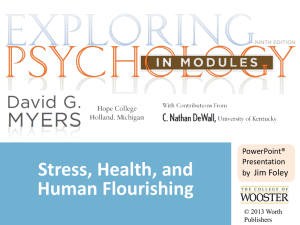Work-related to Stress and Stress Management
advertisement
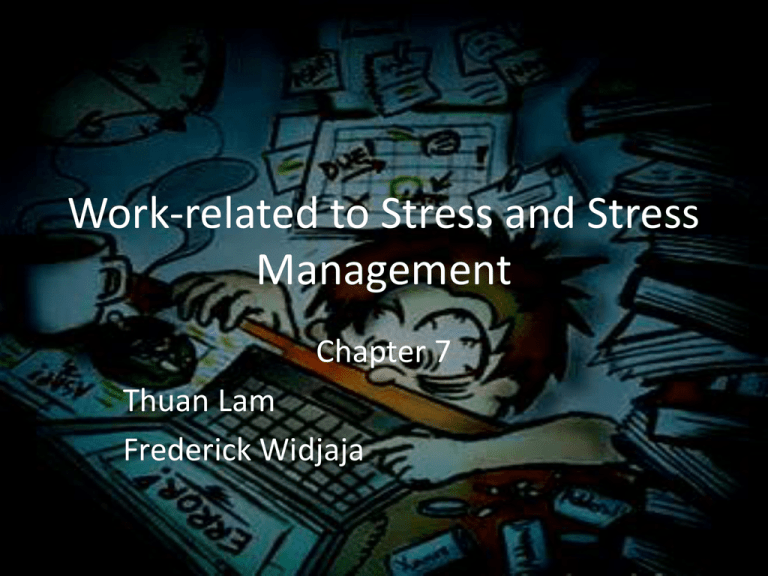
Work-related to Stress and Stress Management Chapter 7 Thuan Lam Frederick Widjaja What is stress ? Stress is the body’s natural response to intense situation that is perceived as challenging or threatening to a person’s well-being. - Distress – Bad stress (is most focused) - Eustress – Good stress General Adaption Syndrome - Alarm Reaction: The alarm reaction stage occurs when a threat or challenge activates the physiological stress responses. - Resistance: The person’s ability to cope with the environmental demand rises above the normal state during the resistance stage. - Exhaustion: People have a limited resistance capacity, and if the source of stress persists, they will eventually move into the exhaustion stage Stressors: The Causes of Stress Stressors, the causes of stress, include any environmental conditions that place a physical or emotional demand on a person Work-related stressors Interpersonal stressors Role-related stressors Task control stressors Organizational/physical environment stressors Interpersonal Stressors (The most pervasive in the workplace) Workplace Violence Who’s experienced stress? -Victim -Observer - Non-directly experienced or observed violence if they work in jobs that expose them to a higher incidence of violence Psychological and Sexual Harassment Psychological harassment includes: -Repeated and hostile or unwanted conduct - Verbal comment, actions, or gestures that affect an employee’s dignity or psychological or physical integrity and that result in a harmful work environment for the employee. Sexual harassment includes: - Unwanted sexual relations (called quid pro quo) - Experiences sexual conduct from others (called hostile work environment) Role-Related Stressors Role conflict refers to the degree of incongruity or incompatibility of expectations associated with a person’s role Role ambiguity refers to the lack of clarity and predictability of the outcomes of a person’s behavior. Work Overload – working more hours and more intensely during those hours than they can reasonably handle. Task Control Stressors The degree to which low task control is a stressor increases with the burden of responsibility the employee must carry Organizational and Physical Environment Stressors -Downsizing is stressful for those who lose their jobs - Layoff survivors also experience stress because of the reduced job security, chaos of change, additional workloads, and guilt of having a job as others lose theirs. Work-Nonwork Stressors (stressors from work spill over into nonwork and vice versa) Time-Based Conflict: refers to the challenge of balancing the time demanded by work with family and other nonwork activities Strain-Based Conflict: occurs when stress from one domain spills over to the other. Role Behavior Conflict: occurs when people are expected to act quite differently at work than in nonwork roles. Stress and Occupations Accountant Hospital manager U.S. president Artist Physician (GP) Prison officer Auto mechanic Psychologist Teacher Forester School principal Nurse Low-stress occupations Medium-stress occupations High-stress occupations Individual Differences in Stress (People have different stress experiences when exposed to the same stressor.) 1. They have different threshold levels of resistance to the stressor. 2. People use different coping strategies, some of which are more effective than others 3. People have different beliefs about the threat and their ability to withstand stress. Resilience and Stress The capacity of individuals to cope successfully in the face of significant change, adversity, or risk Workaholism and Stress Classic workaholic – work addict is highly involved in work, feels compelled or driven to work because of inner pressures, and has a low enjoyment of work Enthusiastic workaholics have high levels of all three components – high work involvement, drive to succeed, and work enjoyment. Work enthusiasts have high work involvement and work enjoyment, but low drive to succeed. Consequences of Distress (physiological, psychological, and behavioral) Physiological Consequences: the stress response shuts down the immune system, which makes use more vulnerable to viral and bacterial infection. Psychological Consequences: job dissatisfaction, moodiness, depression, lower organizational commitment + JOB BURNOUT: the process of emotional exhaustion, cynicism, and reduced feelings of personal accomplishment resulting from prolonged exposure to stress Interpersonal and role-related stressors Emotional exhaustion Cynicism Reduced efficacy Physiological, psychological, and behavioral consequences Psychological Consequences (cont’d) Emotional exhaustion (compassion fatigue): is characterized by a lack of energy, tiredness, and a feeling that one’s emotional resources are depleted. Cynicism (depersonalization): an indifferent attitude toward work and the treatment of others as object rather than people Reduced professional efficacy (reduced personal accomplishment): feelings of diminished confidence in one’s ability to perform the job well. Behavioral Consequences Moderate levels of stress focus our attention and concentrate resources where they are most needed. But when stress distress: - Job performance falls - Memory becomes impaired - Workplace accidents are more frequent - Decision are less effective. Absenteeism is a form of flight – temporarily withdrawing from the stressful situation so that we can reenergize. WORKPLACE AGGRESSION represents THE FIGHT (instead of flight) reaction to stress. Remove the Stressor Withdraw from the Stressor Work-Life Balance Initiatives -Flexible work time - Job sharing - Telecommuting - Personal leave - Child care support Temporary Withdrawal Strategies -Nap rooms, chill-out rooms (sofas, TV, games) - Personal days off, vacation (longer) Remove the stressor Receive Social Support -Valued and Worthy -Help interpret, comprehend, and remove stressors -Help to buffer the stress experience Stress Management strategies Control the Consequences of Stress - Employee Assistance Programs (EAPs) Change Stress Perception Self-leadership practices



